37 Types Of YELLOW Birds In Illinois (ID Guide With Photos)
Did you recently come across a yellow bird in Illinois, and want to know what species it was?
Identifying yellow-colored birds in Illinois is not as easy as it might seem, since there are many species of birds in Illinois that are either entirely or partially yellow.
To help you identify the bird you saw, we’ll cover the most common yellow birds of Illinois in this article.
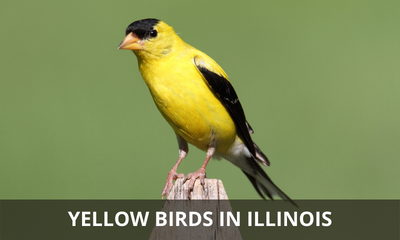
What are the types of yellow birds in Illinois?
The 37 types of yellow birds found in Illinois are:
- American Goldfinch
- Yellow Warbler
- Wilson’s Warbler
- Yellow-rumped warbler
- Common Yellowthroat
- Yellow-breasted Chat
- Eastern Meadowlark
- Western Meadowlark
- Canada Warbler
- Pine Warbler
- Scarlet Tanager (Female)
- Summer Tanager (Female)
- Magnolia Warbler
- Nashville Warbler
- Yellow-headed Blackbird
- Yellow-throated Vireo
- White-eyed Vireo
- Prothonotary Warbler
- Blue-winged Warbler
- Black-throated Green Warbler
- Cape May Warbler
- Mourning Warbler
- Hooded Warbler
- Northern Parula
- American Redstart (Female)
- Great Crested Flycatcher
- Baltimore Oriole (Female)
- Orchard Oriole (Female)
- Cedar Waxwing
- Orange-crowned Warbler
- Dickcissel
- Evening Grosbeak
- Prairie Warbler
While many of these birds are found all year in Illinois, a number of them only occur in the state only during the breeding season in summer.
Yet other species are winter visitors in Illinois, and a few are vagrants that only rarely occur in the state.
Now let’s dive into the details, and take a closer look at each of these bird species:
American Goldfinch
Scientific name: Spinus tristis
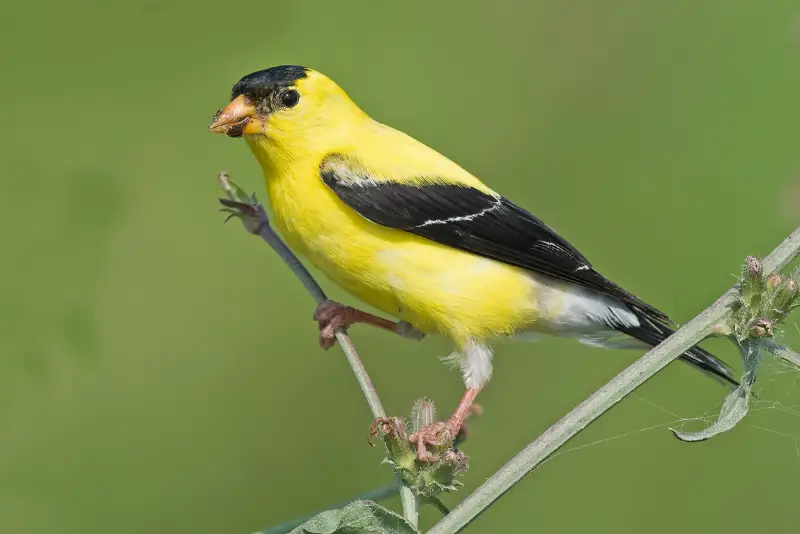
The American Goldfinch is a common breeding bird throughout Illinois, and can be seen between May and September in many parts of the state.
It has a dazzling, bright yellow color with a black forehead.
They have black wings with white markings. The females are a bit quite different though, having a primary olive color and dull yellow underparts that are a lot paler than the male’s.
The American Goldfinch is usually found in weedy fields and floodplains, but can also be found in orchards, roadsides, and as backyard birds.
It generally likes to eat seeds and grains, and is readily attracted to bird feeders that offer black oil sunflower seeds.
Yellow Warbler
Scientific name: Setophaga petechia
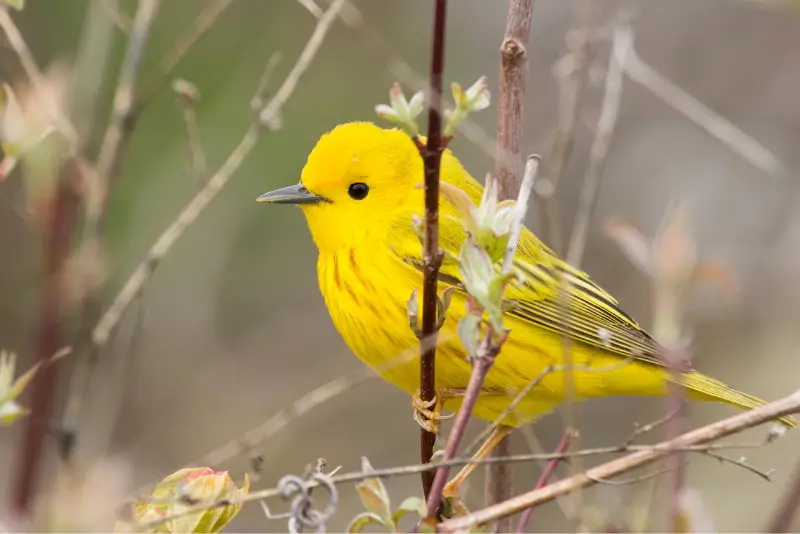
Also known as the American Yellow Warbler, this songbird lives up to its name.
Adult males have a brilliant yellow color, except for their wings, which are just slightly darker and have two pale wingbars.
They also have reddish stripes on the breast and the yellow sides. Adult females are very similar to the males, but have less black streaking and are thus more uniformly yellow.
These bright yellow birds are only seen in Illinois during the summer, between May and September, when they breed in the Prairie State.
It favors open habitat with low thickets and scrubland, which makes it easy to observe.
Wilson’s Warbler
Scientific name: Cardellina pusilla
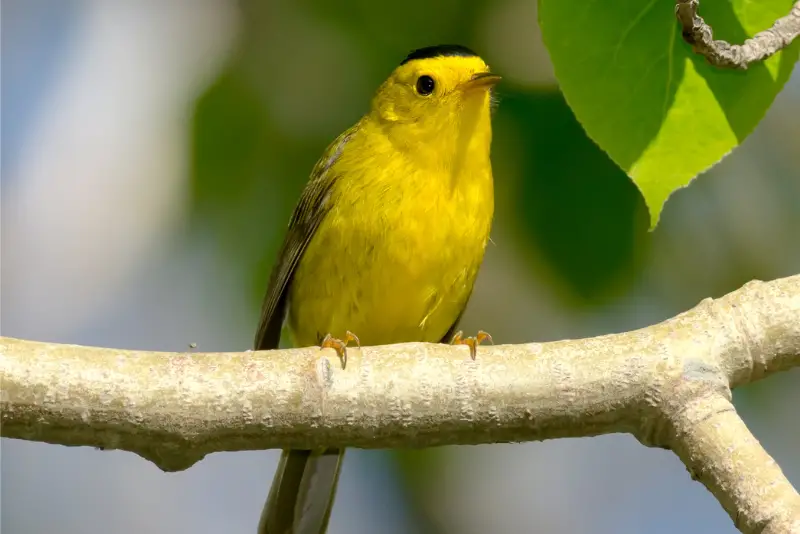
Wilson’s Warbler is a small Illinois bird with olive colored upperparts and yellowish green underparts. In addition, adult males have black caps.
This bird is spotted in Illinois as a visitor during spring and fall migration, as it passes through Illinois from its breeding grounds in Canada to its wintering grounds in Central America.
It prefers damp woodlands with dense shrubs, where it forages for small insects and other invertebrates.
Yellow-rumped Warbler
Scientific name: Setophaga coronata

While the sexes of the Yellow-rumped Warbler don’t look the same, they both have a bright yellow rump.
This warbler exists in several variations, and the eastern population that can be found in Illinois are also called “Myrtle Warblers”.
These small Illinois birds have blueish-gray upperparts with dark streaks, as well as a yellow rump and flanks.
This warbler is a breeding bird of northern Canada and is a winter visitor in south Illinois, where it can be seen from September through April.
Common Yellowthroat
Scientific name: Geothlypis trichas
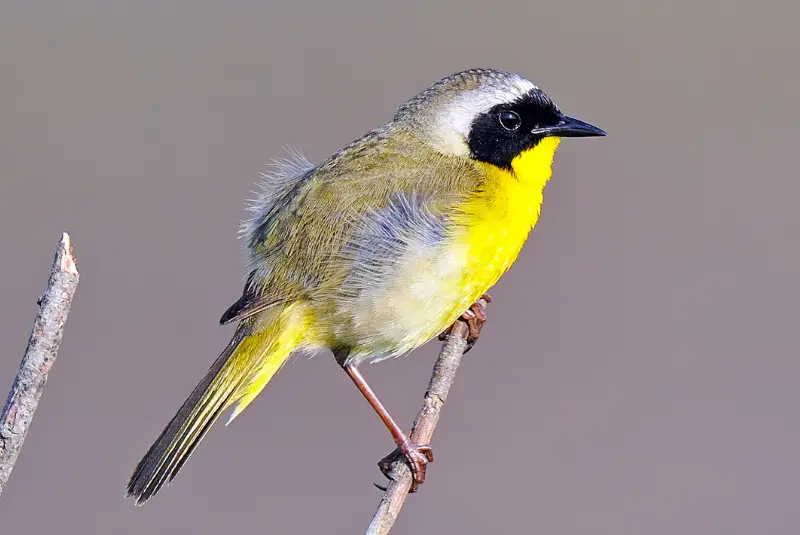
Common Yellowthroats are small songbirds with a brightly colored plumage. Adult males have a vivid yellow throat and chest, as well as a broad black mask that covers the forehead and cheeks.
Their black face mask is bordered on top by a grayish white band, which transitions into the olive brown nape and back. Females are similar, but lack the black face mask.
This warbler is present throughoutIllinois during the summer months from April through August.
It is a migratory bird that spends the winter in the southern United States and Central America. It prefers shrubland and grassy habitats, and feeds on insects and other invertebrates.
Yellow-breasted Chat
Scientific name: Icteria virens

These birds are between the size of a sparrow and a robin. They are an olive-green color with a bright yellow breast, a gray face, and a distinct white eyebrow stripe.
These chats are present as breeding birds in Illinois during the months of May through August.
They can usually be found in dense areas such as thickets, bramble bushes, shrubs, and along streams.
The diet of this bird consists of small insects, such as moths, beetles, ants, and grasshoppers. They also eat berries such as wild grapes and elderberries.
Eastern Meadowlark
Scientific name: Sturnella magna
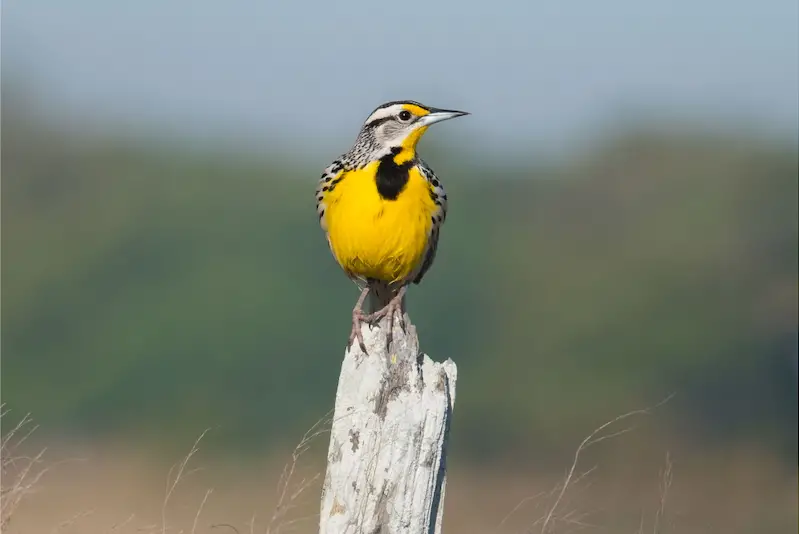
These colorful birds spend most of their time foraging on the ground.
The Eastern Meadowlark, like other American lark species, has a short tail and a conical beak that is ideally adapted for gathering seeds and insects on the ground.
During the breeding season, the eastern meadowlark is most apparent because the males proclaim their territories by singing from a high perch or while flying over the ground.
Depending on the area, the eastern meadowlark may be a year-round resident or a visitor at certain times of the year. It can be seen in Illinois year-round.
The upperparts of adult Eastern Meadowlarks are light brown with black markings, while the underparts are brilliant yellow, with a jet black V on the chest.
Eastern Meadowlarks can be difficult to spot, because they forage on the ground, where they are hidden by vegetation.
Grasslands, farm areas, and moist fields are all suitable habitats for Eastern Meadowlarks, as long as they can locate a territory that is large enough to raise a family.
During the summer months, males sing lovely melancholy whistles on exposed perches, particularly fence posts.
Western Meadowlark
Scientific name: Sturnella neglecta
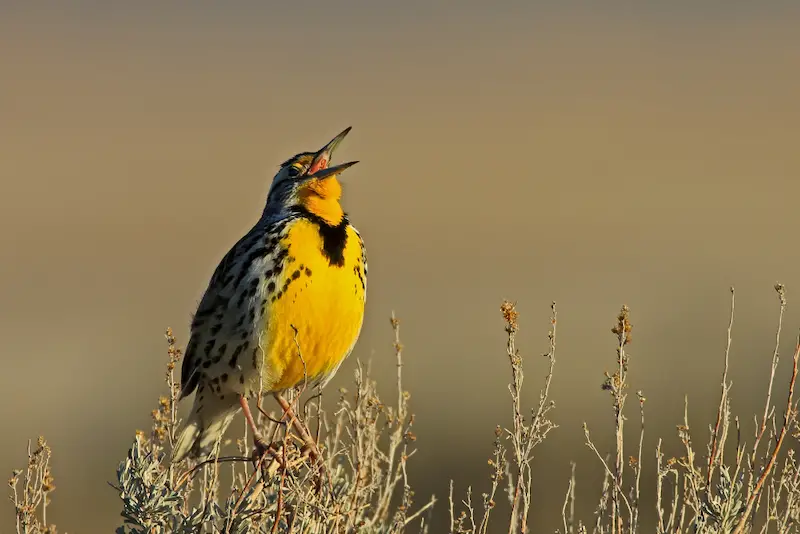
The Western Meadowlark closely resembles the Eastern Meadowlark, but is found in more western areas of North America.
It occurs in north Illinois as a breeding bird, and can be seen in the rest of the state during the winter months.
Although the two meadowlark species closely resemble each other, and their ranges overlap considerably, they almost never form hybrids.
This species is a favorite among birdwatchers, due to the fact that the male likes to sing loudly from a conspicuous perch, or while flying over its territory.
Combined with its striking black and yellow coloration, this makes the Western Meadowlark a pure joy to observe.
The very distinct songs of the two species of meadowlark allow for easy differentiation between them.
Canada Warbler
Scientific name: Cardellina canadensis
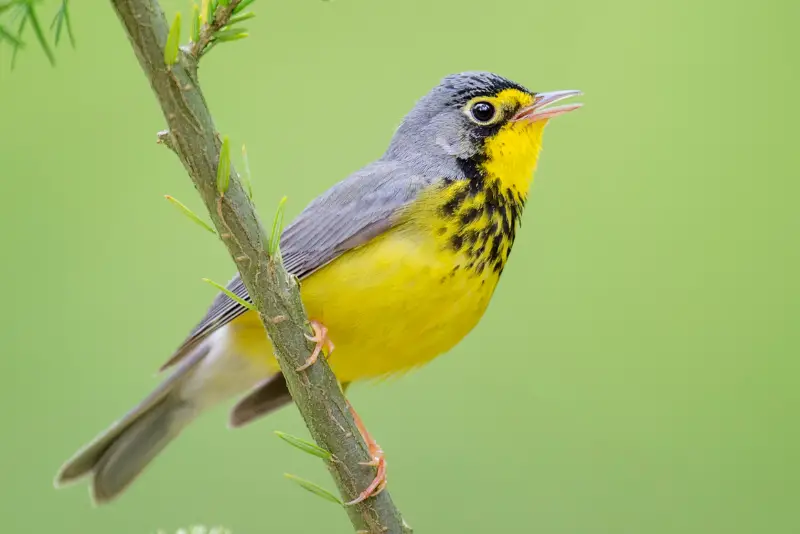
The Canada Warbler is a vibrant small songbird that may be found as a breeding bird in Canada and northern states of the eastern USA.
The sexes look different, but both have blue-gray upperparts and bright yellow underparts. Adult males also have a band of dark streaks that divides the throat from the breast.
The Canada Warbler is a migratory bird that can be seen on its passage through Illinois in spring and fall.
It favors damp forests with plenty of undergrowth, and is often found near water. It winters in South America.
Pine Warbler
Scientific name: Setophaga pinus
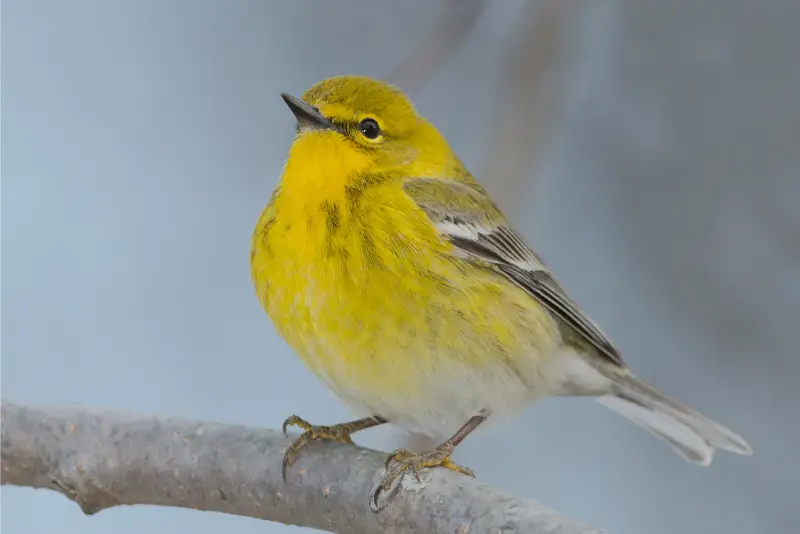
The Pine Warbler is almost always found in the vicinity of pine trees, which explains how it got its name.
Adult males have olive colored upperparts, as well as a yellow head and underparts, except for a white belly. The females are more grayish buff.
During the months of April through September, the Pine Warbler may be encountered nesting in the woods of southern Illinois.
It forages in the underground of pine forests, which makes it relatively easy to observe.
Scarlet Tanager (Female)
Scientific name: Piranga olivacea
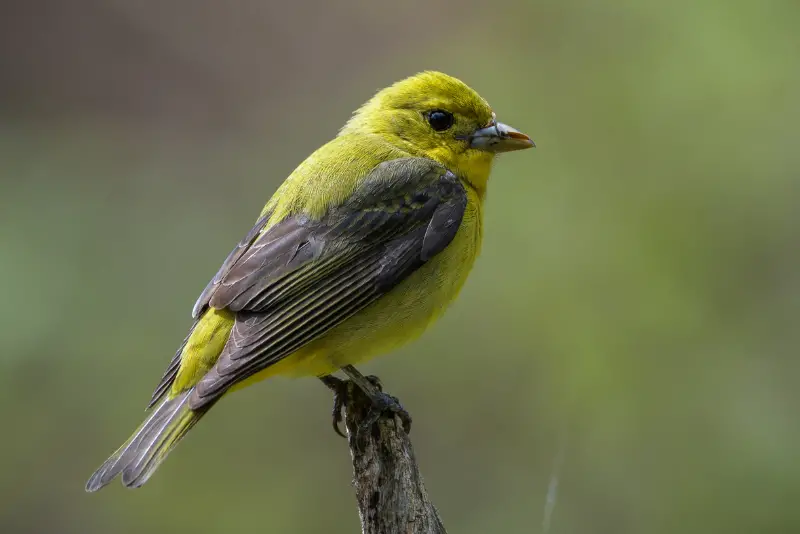
While male Scarlet Tanagers have a tropical appearance, due to their bright scarlet plumage, the female looks like a distinct species, and is more dull yellow in color.
The Scarlet Tanager is a summer visitor and breeding bird in Illinois, and spends its winter in Central and South America.
This bird loves warm temperatures, and thus arrives late in spring, and leaves early in fall. During fall, Scarlet Tanagers fly south to spend the winter in South America.
Both sexes sing a similar song in order to mark and defend their territory from other birds.
Summer Tanager (Female)
Scientific name: Piranga rubra
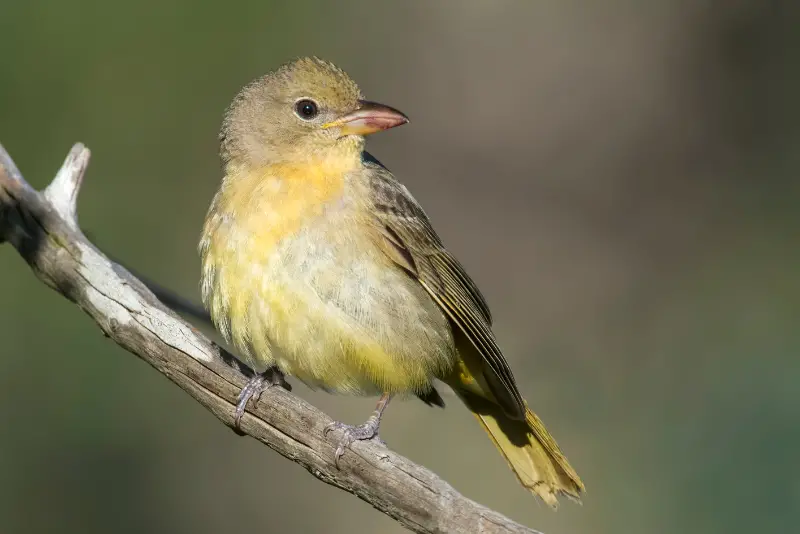
The Summer Tanager is a stunningly beautiful songbird of North America.
While adult male Summer Tanagers are entirely bright red Illinois birds, females and immatures are buff yellow, although they sometimes have a few patches of orange.
It can be hard to observe Summer Tanagers, since they like to forage high in the treetops of deciduous and mixed forests.
The Summer Tanager is a scarce summer visitor in southern Illinois, and can be seen here from May through August.
These birds migrate, and leave Illinois in the fall to spend the cold season in Mexico and Central America.
Magnolia Warbler
Scientific name: Setophaga magnolia
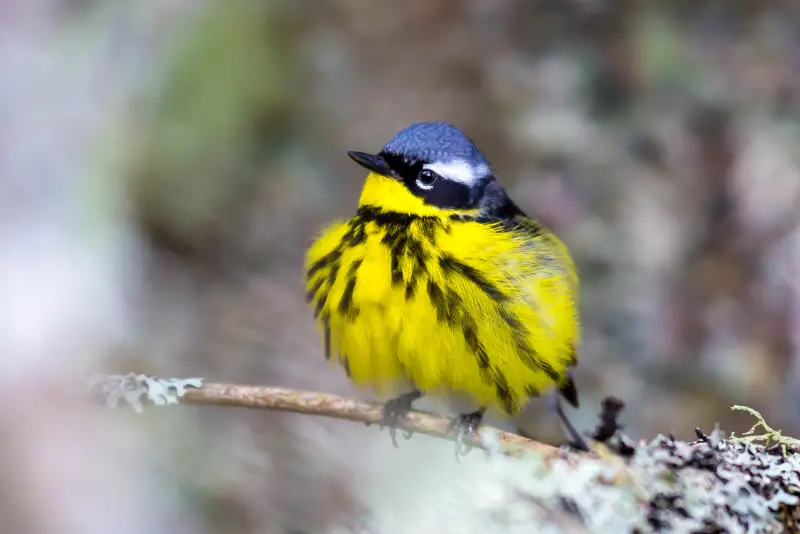
Adult males of this colorful bird have dark upperparts and bright yellow belly with a distinctive black chest band and dark streaks on the flanks.
The crown is blueish gray, and is separated from the light throat by a black mask. Females look similar, but lack the areas of black plumage.
In Illinois, the Magnolia Warbler may be seen on passage during spring and fall migration.
It favors coniferous forests, where it forages for insects and other invertebrates in the dense undergrowth.
Nashville Warbler
Scientific name: Oreothlypis ruficapilla
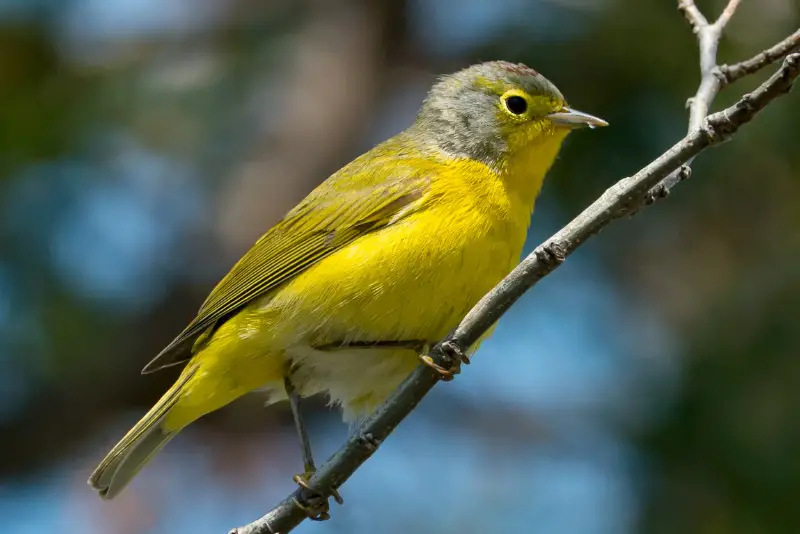
The Nashville Warbler is a beautiful little songbird. Adult males have an olive gray back, a blue gray head, and lemon yellow belly.
Females and juvenile birds are similar to males, but slightly paler and less colorful.
The Nashville Warbler is found as a migratory bird throughout Illinois during spring and fall, as it travels between its breeding grounds in Canada, and its wintering grounds in Central America.
Similar to many other warblers, it migrates to Central America in order to spend the winter. It favors the tangled undergrowth of mixed forests.
Yellow-headed Blackbird
Scientific name: Xanthocephalus xanthocephalus
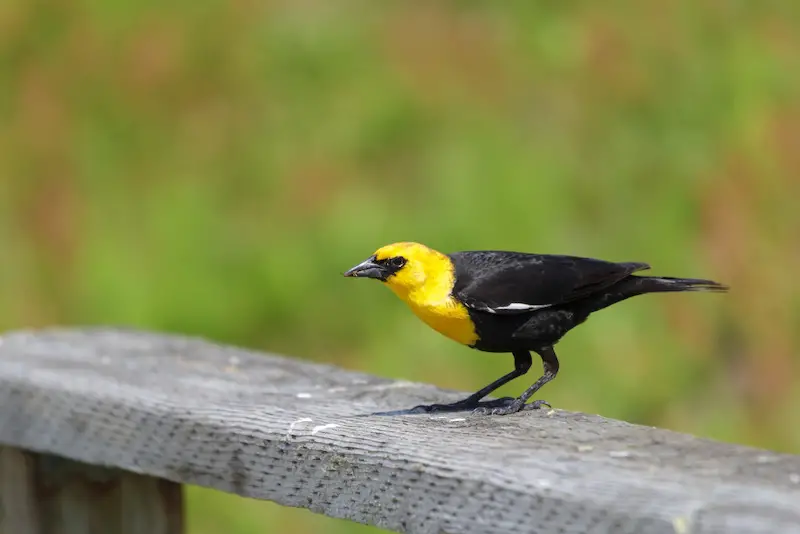
While Yellow-headed Blackbirds are more common in western North America, north Illinois is included within the eastern edge of their range.
Adult males stand out thanks to their distinctive bright yellow chest and head, paired with a mostly black body.
Females and immatures of this blackbird have more drab coloration and are dark brown rather than black.
Males will often mate with a number of different females during the breeding season, forming small colonies of nests.
Outside of the breeding season, these blackbirds gather into massive flocks, frequently mingling with other species of blackbirds, and feed on leftover grains on farmland.
At this time it is common for this blackbird to forage in fields and spend their winters in open cultivated areas.
During the summer months, they feed mostly on insects and other small invertebrates.
Typically, these birds breed in lowland areas with wetlands and dense growth of cattails. This Illinois blackbird is most often observed during migration in fall and spring.
Yellow-throated Vireo
Scientific name: Vireo flavifrons
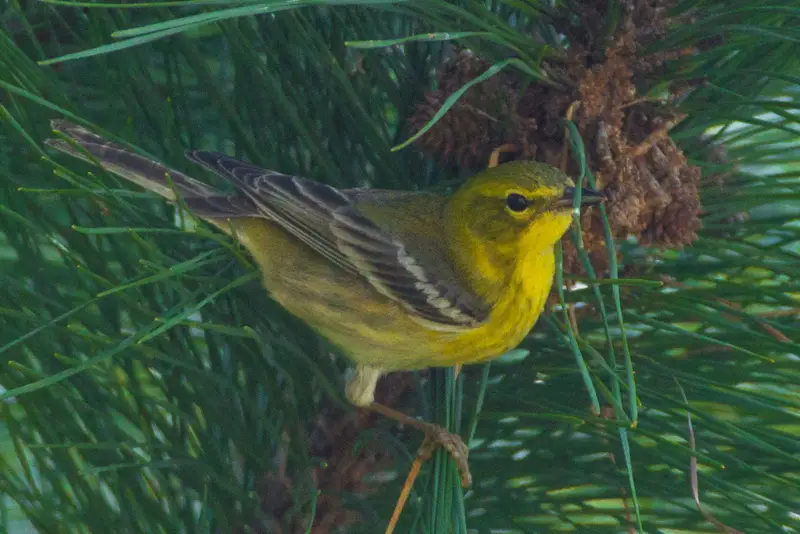
The Yellow-throated Vireo is a brightly colored songbird with a thick beak, and a head that is disproportionately large.
Both sexes look similar and have yellow and gray upperparts, yellow stripe over the eye, as well as a yellow throat and breast. Their dark wings have two white wingbars.
During the months of April through August, this bird may be seen breeding throughout the state of Illinois.
This yellow-colored bird favors dense forests, and is hard to observe as it usually forages in the tree tops. It migrates to Central America to spend the winter.
White-eyed Vireo
Scientific name: Vireo griseus
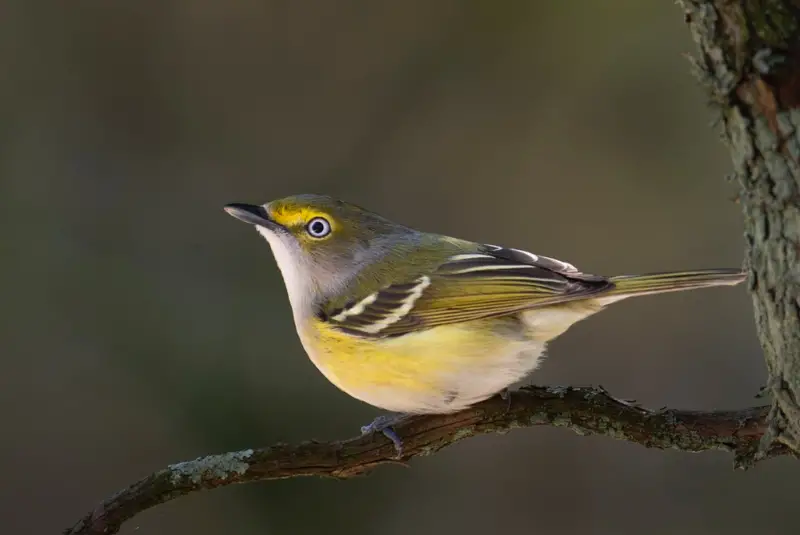
The White-eyed Vireo is a small bird with grayish brown upperparts and pale yellow flanks.The underparts are buff white, and there are two distinctive white wing bars.
A great feature to identify it by is its pale iris, which distinguishes it from many other similar birds.
The White-eyed Vireo is a summer visitor in Illinois, and is present in the state from April to September. It breeds in deciduous forests, and feeds on insects and other small invertebrates.
Prothonotary Warbler
Scientific name: Protonotaria citrea

A small bird, the Prothonotary Warbler is a summer visitor in Illinois, and spends the winter in the Gulf Coast and Central America.
Male Prothonotary Warblers are bright yellow with gray-blue wings and long tail, as well as black eyes.
If you were to look at this bright yellow bird from underneath, you would see its white belly. The females are very similar to the males, but are more often than not slightly paler yellow.
You’ll usually find Prothonotary Warblers in woodlands near streams and lakes, as well as in wooded swamps.
Their diet mainly consists of snails and insects you’d find in swampy areas.
Blue-winged Warbler
Scientific name: Vermivora cyanoptera
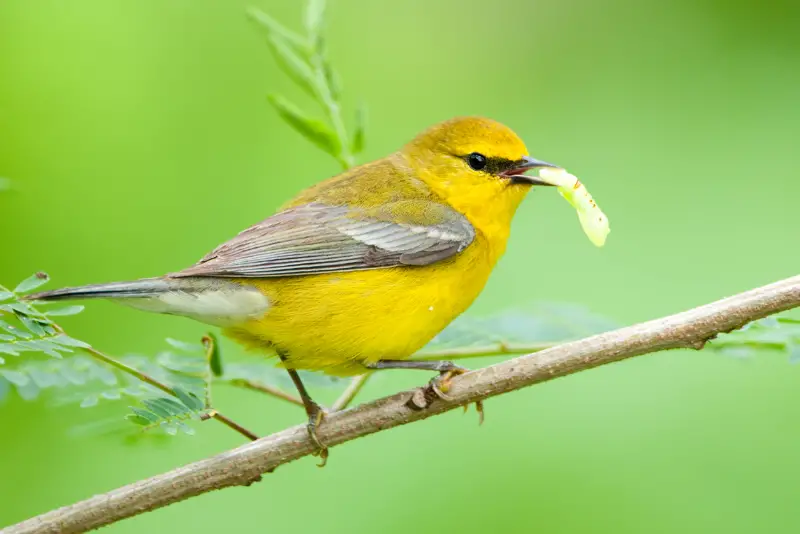
This is a colorful little wood warbler. Adult males can be recognized by their olive back and yellow belly and head.
Their blue gray wings have two subtle white wingbars, while the head has a thin black stripe between the eye and the beak.
Adult females look similar, but slightly more drab and less intensely colored. This bird favors clearings and forest edges with young trees.
The Blue-winged Warbler occurs as a breeding bird in Illinois during the months of May through August.
Related: Blue birds in Illinois
Black-throated Green Warbler
Scientific name: Setophaga virens

Similar to the Townsend’s Warbler, the Black-throated Green Warbler is also a colorful little warbler.
Adult males have an olive green back, a bright yellow face and cheeks, and a black throat and chest. The belly is buff white with dark streaks in the flanks. Females look similar, but don’t have a black throat.
It is a migratory bird that can be seen in Illinois during fall and spring migration.
This yellow-colored bird favors mixed and coniferous forests, and migrates to the Caribbean to spend its winter.
Cape May Warbler
Scientific name: Setophaga tigrina
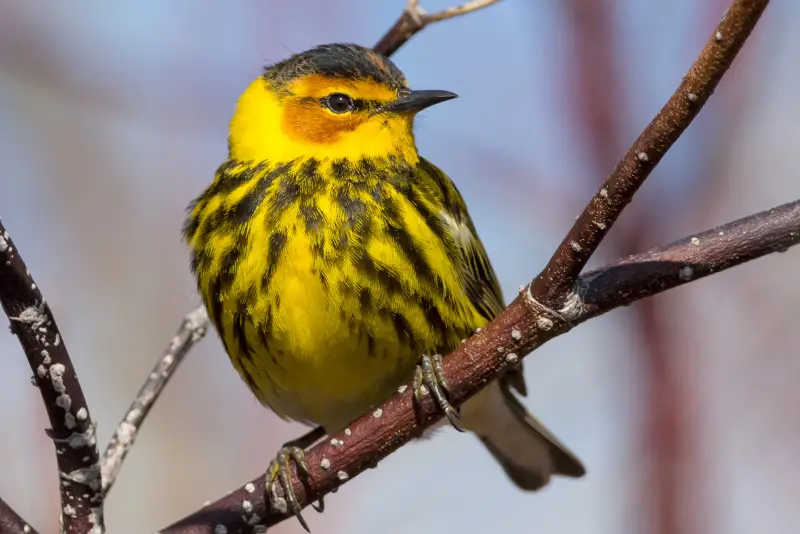
The Cape May Warbler is a northern species that breeds in eastern Canada, and occurs in Illinois during migration.
Adult males have a streaked olive green back, white their face is yellow with chestnut cheeks. Their underparts are yellow with dark streaks.
Females look similar, but are less colorful and more grayish in their overall appearance.
During the months of May through August, the Cape May Warbler may be seen nesting in Canada.
During migration, however, it can be seen throughout Illinois on its way to its wintering locations in the Caribbean.
Mourning Warbler
Scientific name: Geothlypis philadelphia
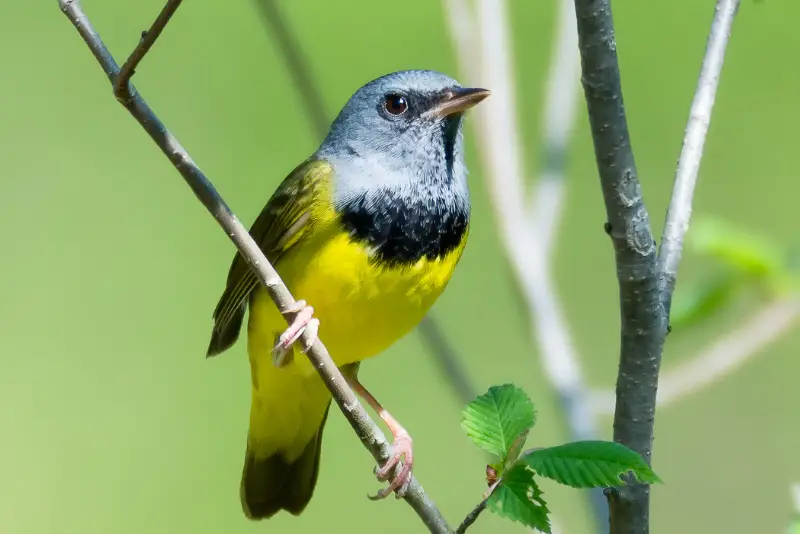
The Mourning Warbler is a colorful ground-dwelling warbler. Adult males have an olive green back, while their belly is golden yellow.
The head and throat are blue gray, and the chest has a black patch towards the top. Females look similar, but are paler overall.
This warbler is a visitor in Illinois during its migrations to and from Central America. It favors shrubland and dense thickets, but is very secretive, and hence hard to observe.
Hooded Warbler
Scientific name: Setophaga citrina
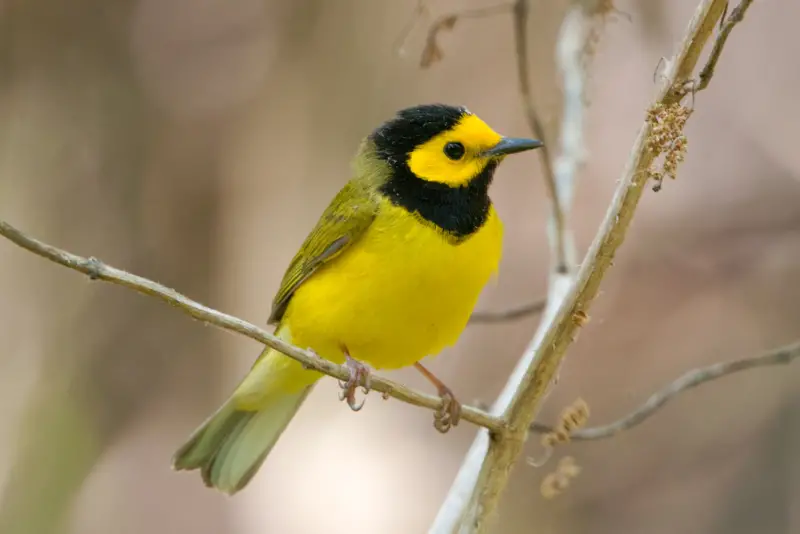
These small yellow birds are common summer visitors in western Illinois, where they can be seen from May to September.
Males have a black hood, which contrasts with brilliant flashes of yellow, while its back is olive green.
Females and immatures are similar to males, but lack the black areas on their head. These birds don’t visit bird feeders, and are most often spotted in backyards during migration.
They prefer forests with dense undergrowth, and winter in Mexico and Central America.
Northern Parula
Scientific name: Setophaga americana
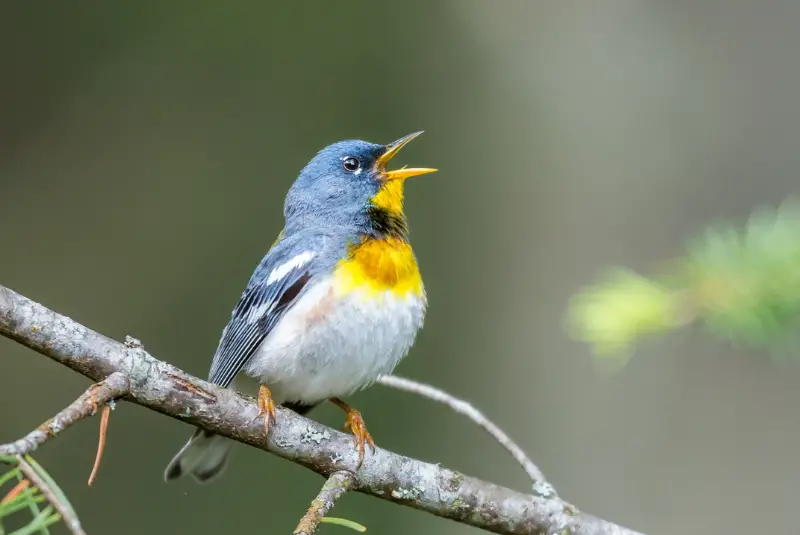
The Northern Parula is a colorful wood warbler that has distinct markings on its body.
The upperparts of adult males are mostly blue, and they have a yellowish green patch on the back, in addition to two white wingbars.
One of the most distinctive features of this bird is the striking yellow throat, as well as a bright orange breast band.
The eye of the Northern Parula has a partial white eyering, which is a great feature for identification of this little warbler.
It is a common summer visitor in south Illinois, where it breeds in deciduous and mixed woodland. It can be seen throughout the rest of the state during spring and fall migration.
American Redstart (Female)
Scientific name: Setophaga ruticilla

While male American Redstarts are orange and black, females have yellow plumage instead of the orange parts of the male.
Females also have much less black, and as a result look like pale green birds with bright yellow patches.
This bird is a common bird throughout Illinois from May through August, and favors a wide variety of woodland habitats, as well as backyards.
It migrates to South America to spend the winter months.
Great Crested Flycatcher
Scientific name: Myiarchus crinitus
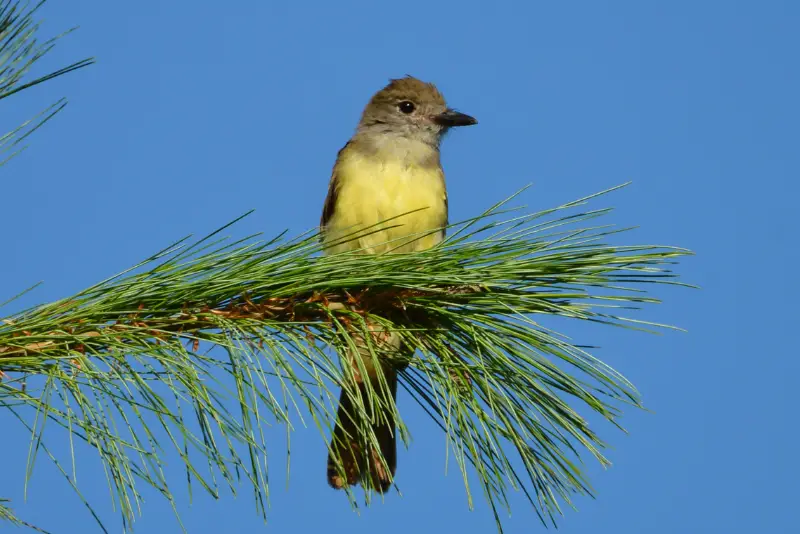
The Great Crested Flycatcher is a slim, long-bodied flycatcher. Adults have a dark brown head and back, as well as a yellowish belly.
The tail is rufous orange, and the crest of this bird is relatively small, and not very useful as a distinguishing feature.
The Great Crested Flycatcher is a common bird in Illinois during the summer, and it can be seen throughout the state from April through September.
It nests in a wide variety of woodland habitats, and feeds on insects as well as berries. Its winter range extends from Central to South America.
Baltimore Oriole (Female)
Scientific name: Icterus galbula
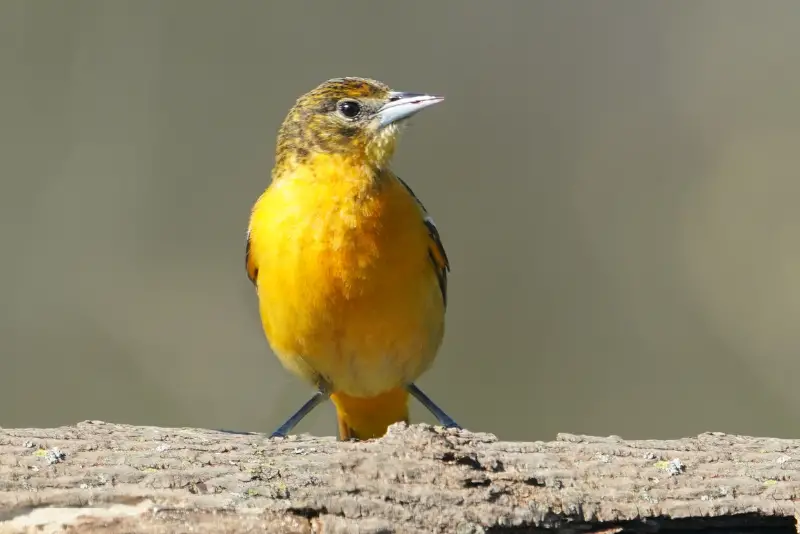
The Baltimore Oriole is a wonderful singer that is more frequently heard than seen.
Adult males are very conspicuous due to their flaming orange belly, paired with a completely black head and back, as well as their black and white wings.
Females and immatures have a more brownish yellow coloration.
Baltimore Orioles are readily attracted to feeders that contain orange halves, grape jelly, or nectar.
And similar to Orchard Orioles, parents bring their recently fledged young to a nearby feeder.
This bird favors open spaces such as yards, parks, and woods, and frequently comes back to the same location year after year.
Keep an eye out for Baltimore Orioles in deciduous forests, but not in dense woods. You may encounter them in places like open forests, forest margins, orchards and even backyards.
Due to the fact that they forage high in trees in search of insects, fruit, and flowers, most orioles are more frequently heard than seen.
The Baltimore Oriole is a summer visitor to Illinois, and can be seen between May and September.
Orchard Oriole
Scientific name: Icterus spurius
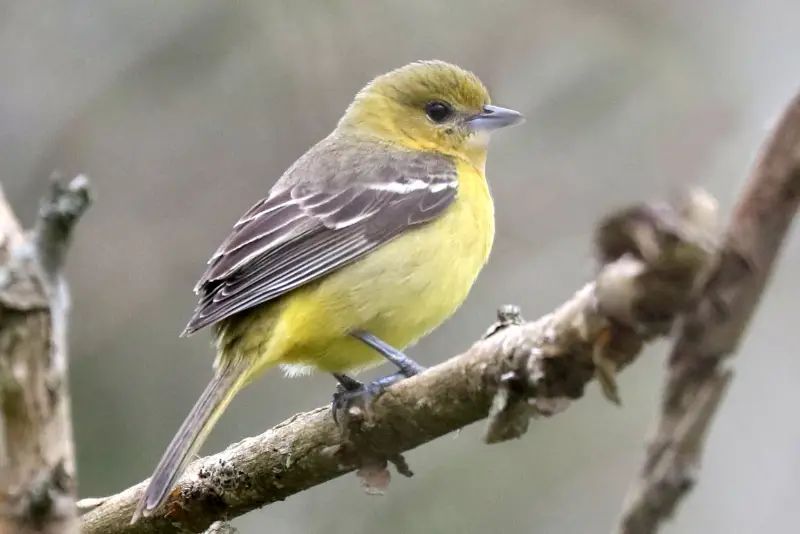
This Oriole got its name from its preference for orchards and open woods. It is a common summer visitor in Illinois, and is found throughout the state.
Unlike the males (which are a combination of black and dark orange), females are mostly yellow.
Young males resemble females in color, and gradually become more and more black over their first two years.
Early in the summer, the Orchard Oriole feeds on insects, but later it will switch to eating wild fruit as they become mature.
After their young have fledged, parent Orioles will bring them to feeding stations (especially if you have a nectar feeder.
Some people mistakenly believe that the Orioles have departed since they do not see them at their feeders very often during the peak of the summer.
However, the birds are still present nearby, but are simply focused on catching insects to bring back to their nestlings.
The Orchard Oriole is one of the birds that gets here very late in the spring and is one of the ones that leaves quite early in the fall.
Cedar Waxwing
Scientific name: Bombycilla cedrorum
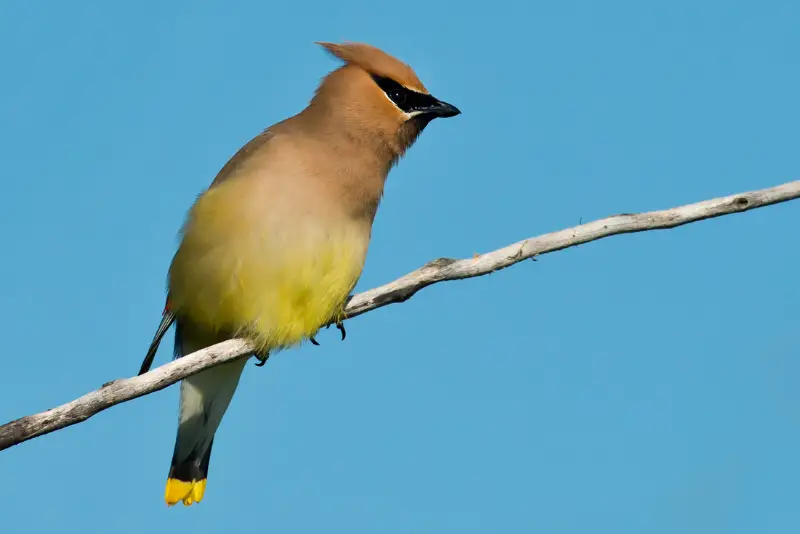
Adult Cedar Waxwings have orange buff colors that fade into light yellow on the underparts. There is a crest on the head, as well as a dark mask around the eyes. Both sexes look similar.
This bird is present in Illinois as an irregular winter visitor. During harsh winters its numbers go up in the Prairie State due to northern birds that move south to escape the cold climate.
During winter, these birds form small flocks that are nomadic, and wander around in search of areas with food, such as berry bushes.
Orange-crowned Warbler
Scientific name: Oreothlypis celata
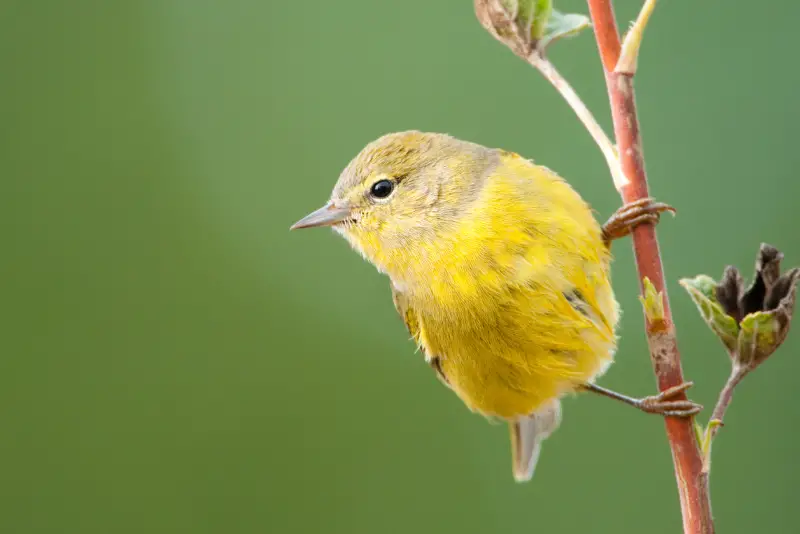
The orange patch on the head of the Orange-crowned Warbler is difficult to notice and is therefore not a helpful field trait to use for its identification.
Adult males are greenish yellow in color, with the upper portions a somewhat deeper shade than the lower bellies. They have a yellow-buff undertail and faint stripes on the underparts.
Adult females and juveniles have less vibrant colors than males, and are more grayish yellow tones.
The Orange-crowned Warbler is a visitor in Illinois during migration in spring and fall.
Dickcissel
Scientific name: Spiza americana
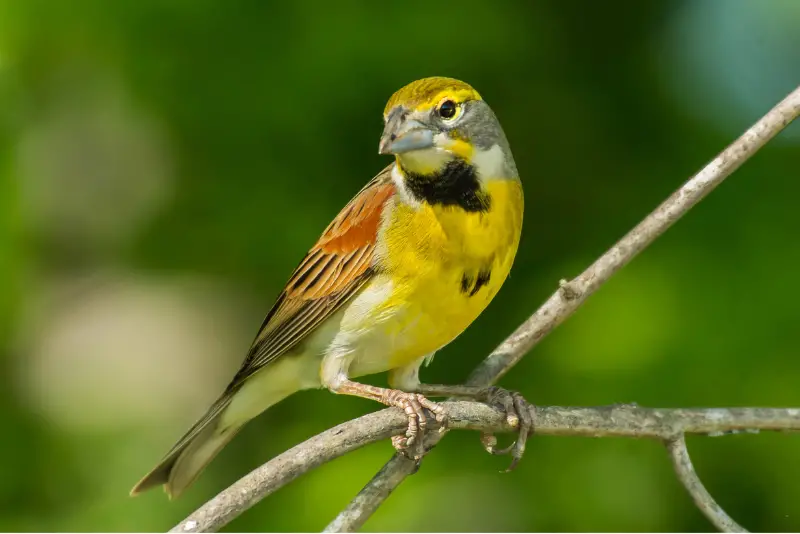
The Dickcissel is a songbird that resembles a sparrow, but has more colorful markings.
The backs of adult males are marked with black stripes of gray-brown and reddish brown, and they also have a gray nape.
They have a bright yellow eyebrow stripe, as well as a yellow malar stripe, and a yellow breast.
Females and juveniles are less colorful, and lack the yellow and black plumage of the males.
It is a summer breeding visitor throughout most of Illinois, and is present from May through August.
Its preferred habitat are grassland and prairies, and it forms large flocks outside of the breeding season.
Evening Grosbeak
Scientific name: Coccothraustes vespertinus
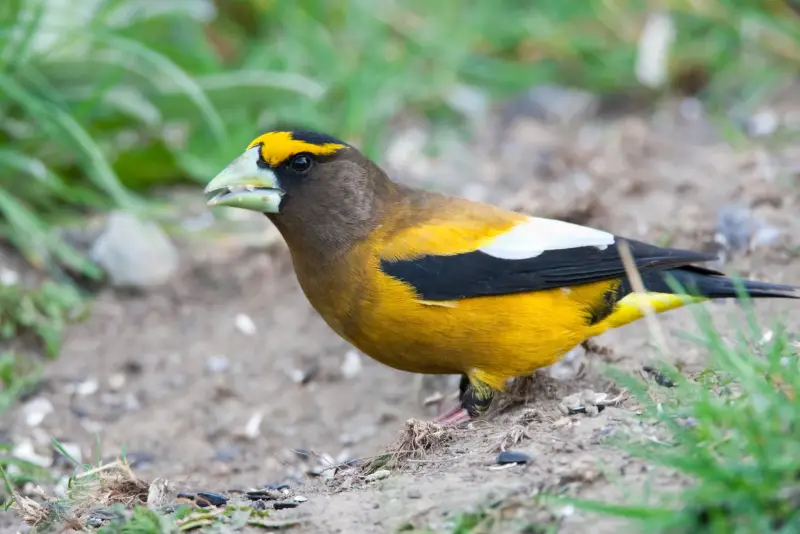
The Evening Grosbeak is a large finch with a massive bill that makes it easy to recognize.
Adult males have a bright yellow forehead, mantle, and golden underparts. Females and immatures are mostly buff gray.
The Evening Grosbeak is a scarce winter visitor in Illinois, though its numbers can increase in years with high yields of pine seeds.
These yellow birds form flocks in winter, and are rare visitors at Illinois bird feeders in the cold months.
Prairie Warbler
Scientific name: Setophaga discolor
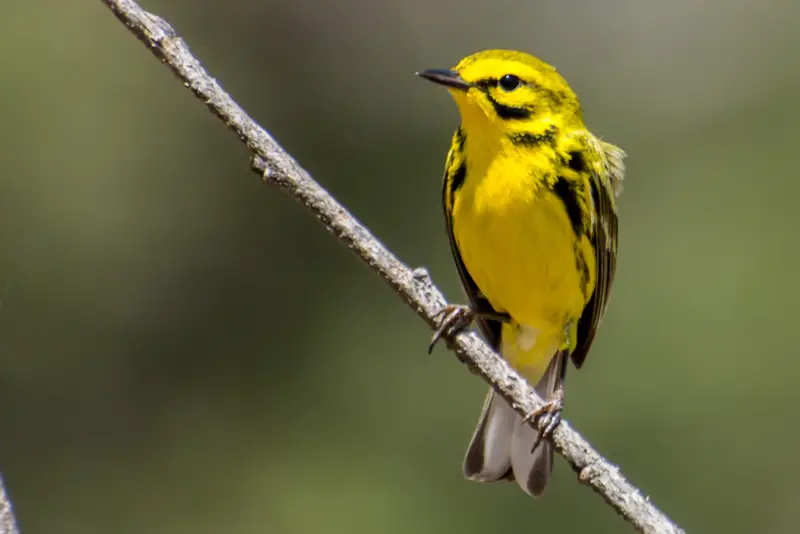
The Prairie Warbler is a beautiful small songbird of young forests and shrubland.
The upperparts of adult males are olive-yellow, with slightly darker wings that feature two pale wingbars.
The belly and throat are bright lemon yellow, as is their face, except for dark eye stripes. The flanks have dark streaks on them.
Females and juveniles look similar, but have less distinctive streaks on their face and flanks.
This warbler is a widespread summer visitor in southern Illinois, where it occurs from May through August. It winters in Florida and the Caribbean region.
What Illinois birds are yellow and black?
The following 10 types of birds in Illinois are yellow and black:
- American Goldfinch
- Yellow-headed Blackbird
- Eastern Meadowlark
- Common Yellowthroat
- Yellow-throated Warbler
- Black-throated Green Warbler
- Magnolia Warbler
- Wilson’s Warbler
- Canada Warbler
- Hooded Warbler
As you can see, there are many yellow and black birds in Illinois.
The most common of these are American Goldfinches, which are present in Illinois during the winter.
So if you spot a bird that is yellow with black while bird watching, this is the first species that you should check for.
If you’re not sure which one of these birds you saw, check out our detailed description and ID photos above.
What small Illinois birds are yellow?
The most common small yellow birds in the Prairie State are American Goldfinches, which are widespread breeding birds in forests and urban areas.
Apart from Goldfinches, the smallest yellow birds in the state are warblers. There are no less than 14 types of yellow warblers in Illinois, the most common of which is the Yellow Warbler.
If you’re not sure which one of these birds you saw, check out our detailed descriptions and ID photos above.
If you enjoyed this article, check out our guide to the raptors of Illinois.
